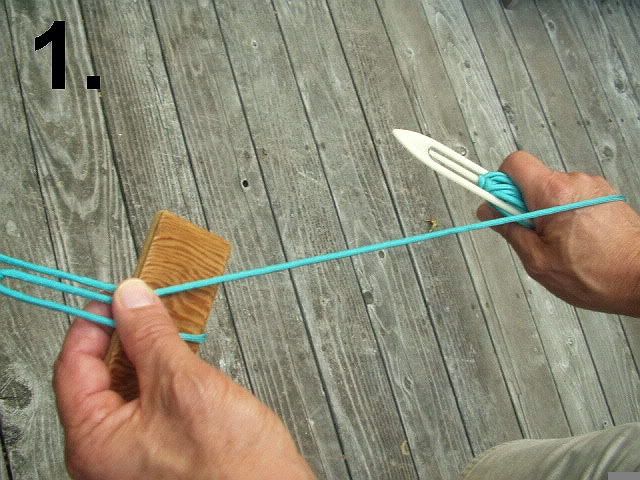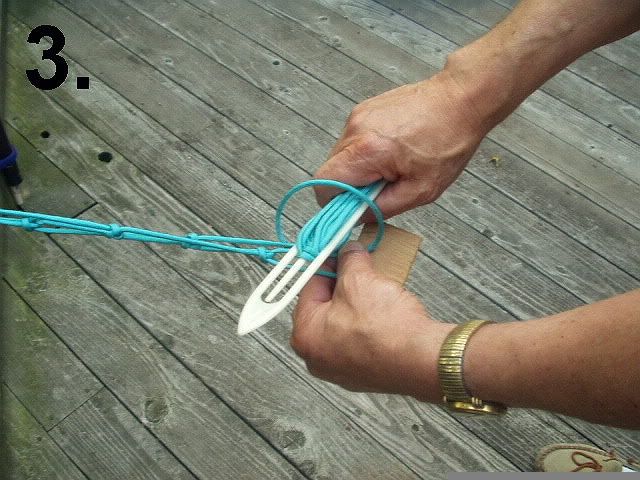|
|
Post by asemery on Jul 28, 2014 23:39:50 GMT
I have presented this method in other forums but none dedicated just to making nets. The method will work with double knotting as well. I now find it difficult to tie the sheet bend in the traditional way most net makers use. Tony At one of my net making demonstrations years ago a spectator who was a tatting expert suggested this method. It eliminates the need to make a bight to the left of the loop you are tying into. This results in a increase in the speed of the netting process. I have since used this method to teach beginning net makers. It is a lot less confusing than the traditional method to teach (and learn). Good Luck. Tony 1. Instead of making the bight (loop) to the left, bring the needle to the right with the cord around the back of your hand. 2. Bring the needle behind the 2 strands as usual, the cord stays around the back of your hand. 3. Back your hand out of the loop and tighten as usual.    |
|
|
|
Post by AJ on Jul 29, 2014 11:38:42 GMT
It would be interesting to know how it works after a few meshes made. With the way I knit I usually depending on how full the needle is get between 2 and three half meshes on one turn off the needle. In your example pictures the length between the bite on the board and the needle is quite long. How does it work when that distance is decreased when knitting, and does the action of putting the twine behind your hand create a twist in the twine?
AJ
|
|
|
|
Post by asemery on Jul 29, 2014 20:21:32 GMT
It would be interesting to know how it works after a few meshes made. With the way I knit I usually depending on how full the needle is get between 2 and three half meshes on one turn off the needle. In your example pictures the length between the bite on the board and the needle is quite long. How does it work when that distance is decreased when knitting, and does the action of putting the twine behind your hand create a twist in the twine? AJ The length of twine between the board and the needle is about the same as in regular netting but stretched out. As you pull the new half mesh tight you put your hand under the twine, no twist is formed. Tony |
|
|
|
Post by threelander on Jul 30, 2014 12:41:58 GMT
looks a little awkward to me and i can,t see how it would make you increase your speed to be honest.only my opinion
|
|
|
|
Post by AJ on Jul 30, 2014 16:49:59 GMT
looks a little awkward to me and i can,t see how it would make you increase your speed to be honest.only my opinion As with any new technique it takes time to embed in your mind, even if just making a few purse nets the way you knit, you do unconsciously, it is as though a pattern has developed in your mind. To change that pattern takes time, and it all depends how old you are as to how quick you can learn that new pattern. Most of us when making long nets just plod on, not really thinking about what we are doing. When I was making the pocket net you have to think, and I found myself a few times just going on to auto pilot and making a mess of things. That said, if you were just learning, then it would be as easy a way to learn as throwing a loop. AJ |
|
|
|
Post by asemery on Jul 30, 2014 17:09:58 GMT
As with any new technique there is a leaarning curve. As you are snugging the new half mesh around the gauge you swing your hand under the twine that is coming brom the bottom of the needle. This is the loop that you would next be putting to the left if you were netting in the traditional manner. The elimination of this one step is is where the speed increase cones. A fracton of a second per mesh but with a large net it adds up.
I found that eliminating the "loop to the left" step makes it less confusing when I teach netmaking at my demonstratons. Tony
|
|
|
|
Post by AJ on Jul 31, 2014 11:32:33 GMT
I( don't know if this will work, I will give a go though. When I throw a loop I do it as the needle is going forward towards making the bite. To be honest I don't think I could go much quicker.
AJ
|
|
|
|
Post by threelander on Jul 31, 2014 12:41:46 GMT
looks fast enough to me allan can,t see anything thats gonna make it any faster than that.
|
|
|
|
Post by asemery on Jul 31, 2014 16:11:32 GMT
If I could knit as fast as that I wouldn't need the over the wrist method. Tony
|
|
|
|
Post by longnetter on Aug 25, 2014 13:57:13 GMT
I'm liking this method asemery, thanks very much.
My situation is different in that arthritis has slowed me right down so I'm in a better position to learn a new method (that's going to be difficult after all these years) that might speed things up a little. But for all you healthy young newbies the best advice is to concentrate on quality and let your speed biuld up naturally with experience as it certainly will
|
|